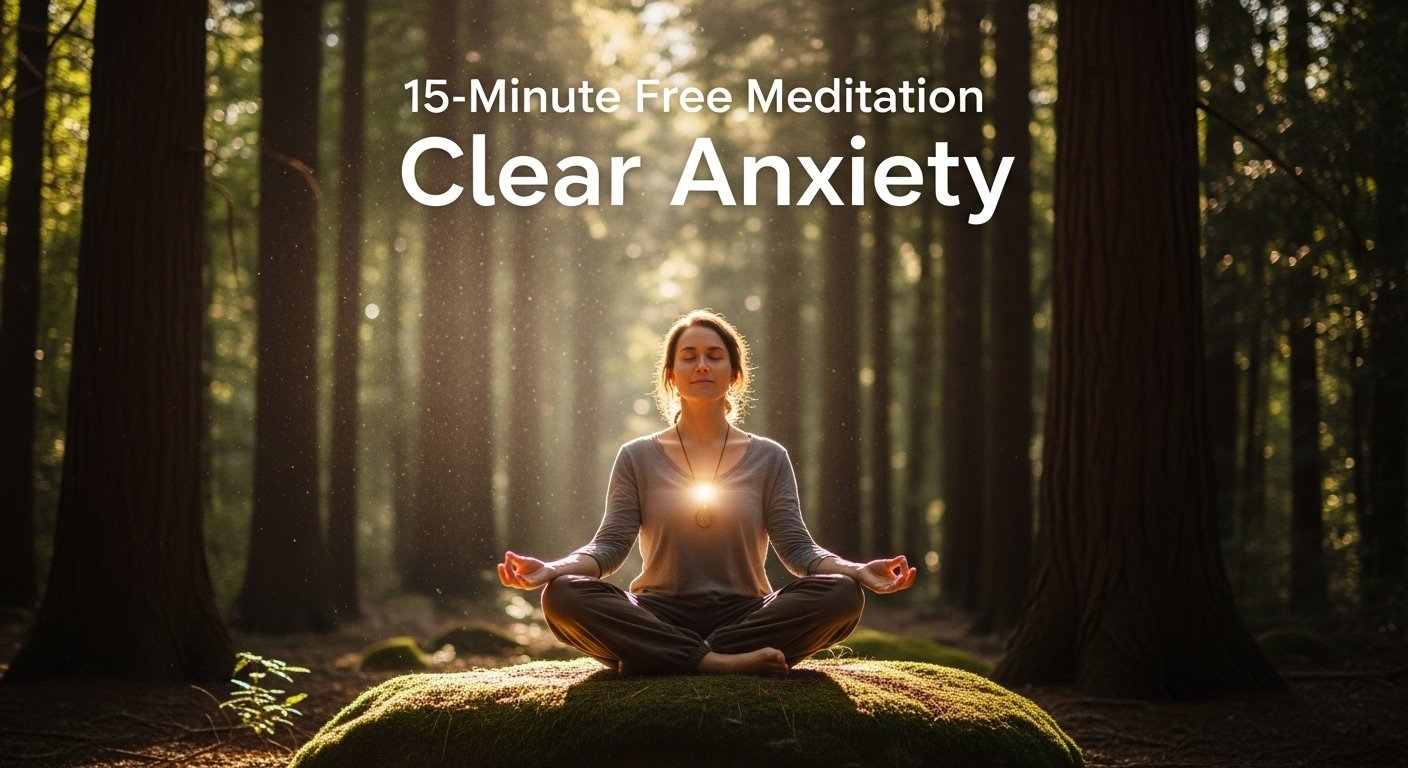Anxiety affects millions of people worldwide, creating a constant state of worry, restlessness, and overwhelming stress that can make even simple daily tasks feel insurmountable. If you’re reading this, you’ve likely experienced those racing thoughts that keep you awake at night, the tight feeling in your chest when faced with uncertainty, or the exhausting mental chatter that never seems to stop.
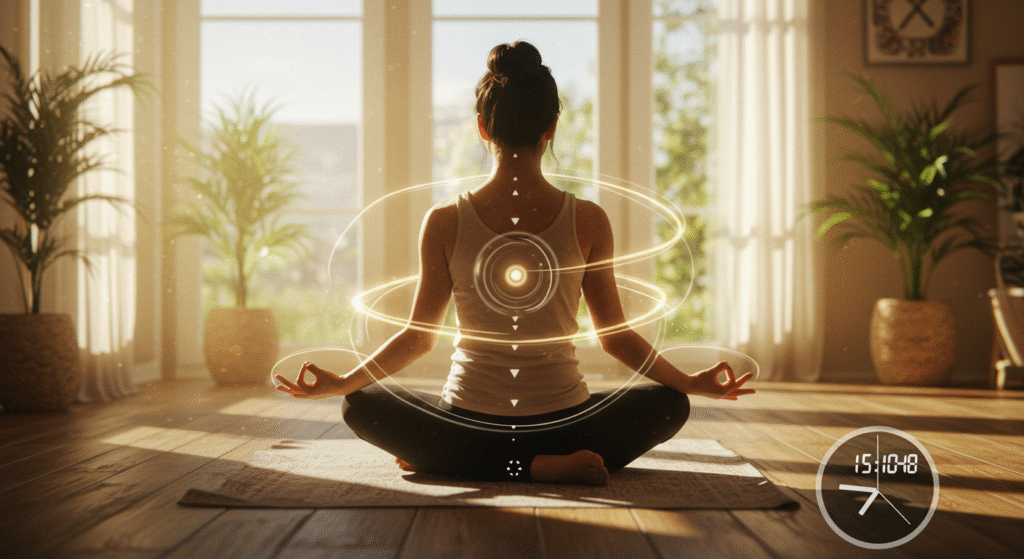
The good news? You don’t need expensive therapy sessions, prescription medications, or hours of your day to find relief. A simple 15-minute meditation practice can be your gateway to calmer thoughts, reduced stress levels, and a more peaceful mind. This comprehensive guide will walk you through everything you need to know about using meditation as a powerful tool for anxiety relief, providing you with practical techniques you can start using today.
In the next 6,000 words, you’ll discover the science behind meditation’s anxiety-busting benefits, learn a complete step-by-step 15-minute meditation routine, and gain practical tips for creating the perfect environment for your practice. Whether you’re a complete beginner or someone looking to deepen your mindfulness journey, this guide offers actionable strategies to help you reclaim your peace of mind.
Understanding Anxiety and How Meditation Helps
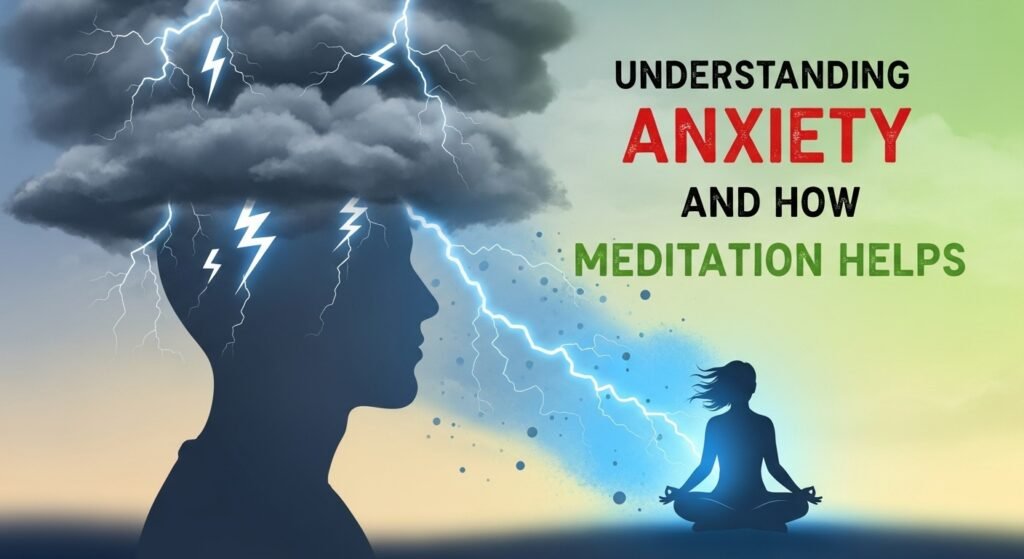
What Happens in Your Brain During Anxiety
When anxiety strikes, your brain activates its ancient alarm system known as the fight-or-flight response. The amygdala, your brain’s fear center, sends distress signals throughout your nervous system, flooding your body with stress hormones like cortisol and adrenaline. This biological response was designed to protect our ancestors from immediate physical threats, but in modern life, it often activates in response to non-life-threatening situations like work deadlines, social interactions, or financial concerns.
During anxious moments, your prefrontal cortex – the brain region responsible for rational thinking and decision-making – becomes less active while the amygdala takes control. This explains why anxiety can make you feel like you’re thinking in circles, unable to find logical solutions to problems that normally wouldn’t seem overwhelming.
Research published in the journal Psychiatry Research shows that regular meditation practice literally changes your brain structure. After just eight weeks of consistent meditation, brain scans reveal increased gray matter in areas associated with learning, memory, and emotional regulation, while showing decreased activity in the amygdala. This neuroplasticity demonstrates that meditation doesn’t just provide temporary relief – it creates lasting changes that make you more resilient to future anxiety.
The Science Behind Meditation for Anxiety Relief
Multiple clinical studies have validated meditation’s effectiveness for anxiety management. A comprehensive meta-analysis published in JAMA Psychiatry examined 47 trials involving over 3,500 participants and found that mindfulness meditation programs significantly reduced anxiety symptoms with effect sizes comparable to antidepressant medications.
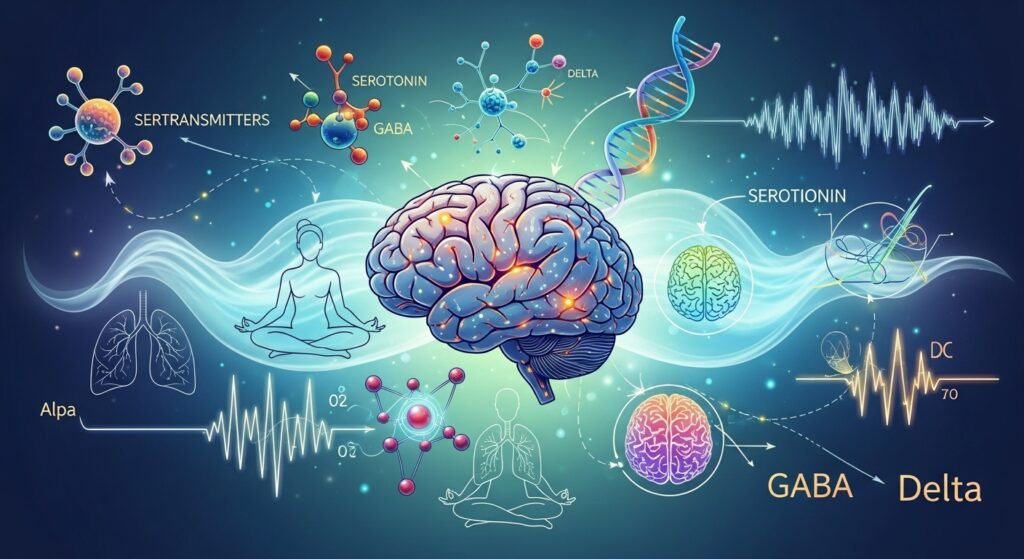
Dr. Sara Lazar’s groundbreaking research at Massachusetts General Hospital used MRI scans to show that meditation increases cortical thickness in areas associated with attention and sensory processing. Participants who meditated for just 27 minutes daily over eight weeks showed measurable changes in brain regions linked to stress reduction and emotional regulation.
The physiological benefits extend beyond brain changes. Regular meditation practice activates the parasympathetic nervous system – your body’s “rest and digest” response – which directly counters the stress response. This activation leads to:
- Decreased heart rate and blood pressure
- Reduced production of stress hormones
- Improved immune system function
- Better sleep quality
- Enhanced focus and concentration
Different Types of Meditation for Anxiety
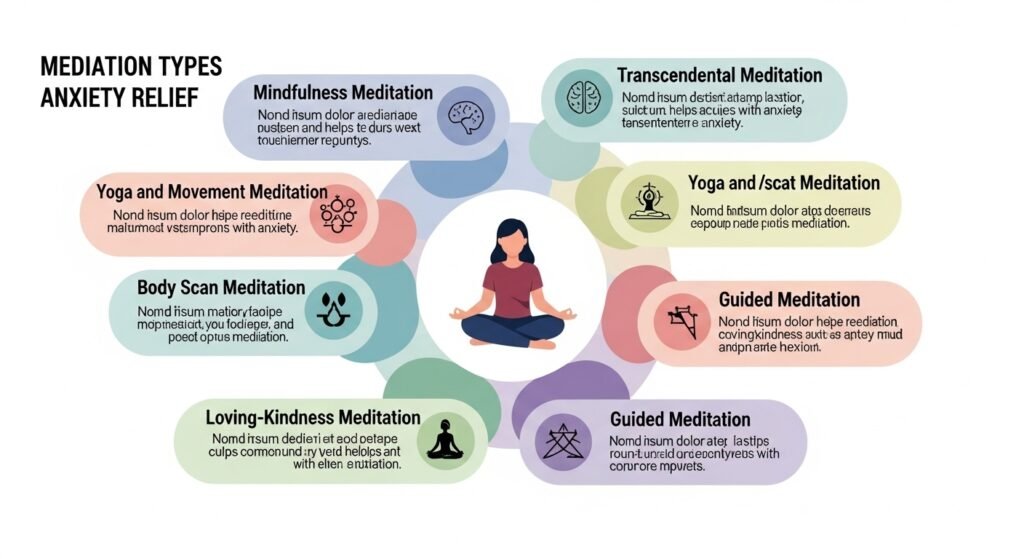
Understanding various meditation styles helps you find the approach that resonates most with your personality and anxiety patterns.
Mindfulness Meditation focuses on present-moment awareness without judgment. You observe thoughts, emotions, and sensations as they arise, learning to witness them without getting caught in their content. This practice is particularly effective for anxiety because it teaches you to step back from anxious thoughts rather than becoming overwhelmed by them.
Breathing Meditation uses breath as an anchor for attention. By focusing on the rhythm of inhalation and exhalation, you activate the vagus nerve, which signals your nervous system to shift into relaxation mode. This technique offers immediate anxiety relief and can be practiced anywhere.
Body Scan Meditation involves systematically focusing attention on different parts of your body, noticing areas of tension and consciously releasing them. This practice helps you develop body awareness and can be especially helpful for physical anxiety symptoms like muscle tension or restlessness.
Loving-Kindness Meditation cultivates feelings of compassion and goodwill toward yourself and others. Research shows this practice reduces self-criticism and negative self-talk, which often fuel anxiety cycles.
Guided Meditation uses recorded instructions or imagery to lead you through the practice. This approach can be particularly helpful for beginners who find it challenging to maintain focus independently.
Benefits of Regular15-Minute Meditation Practice
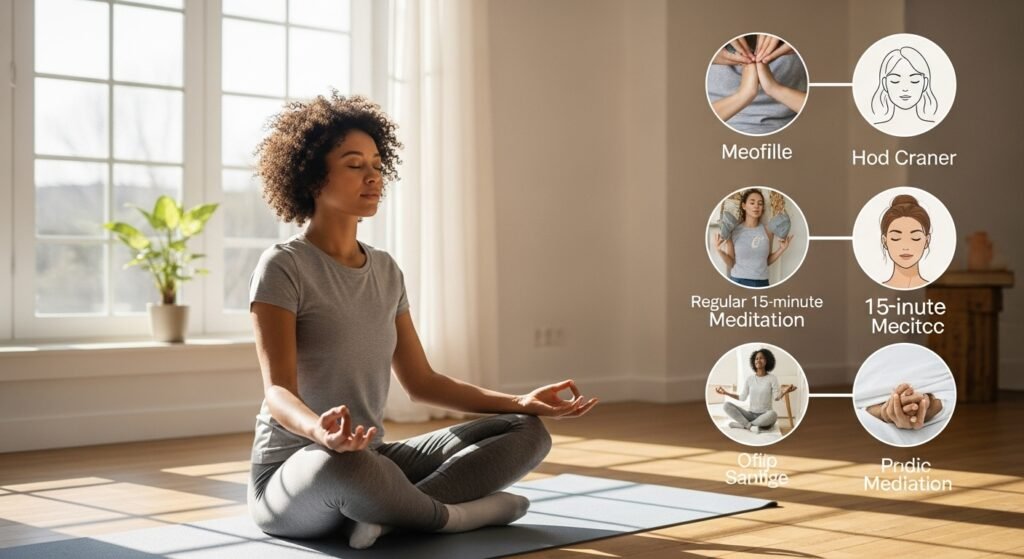
Immediate Short-Term Benefits
Even a single 15-minute meditation session can provide noticeable relief from anxiety symptoms. Within minutes of beginning your practice, you’ll likely experience:
Calmed Nervous System: Deep breathing during meditation activates your parasympathetic nervous system, immediately reducing heart rate and blood pressure. Many practitioners report feeling physically lighter and more relaxed after just one session.
Mental Clarity: Meditation creates space between you and your anxious thoughts, allowing you to observe them without being consumed by them. This mental distance often provides fresh perspective on problems that seemed overwhelming before your practice.
Reduced Physical Tension: Anxiety manifests in the body through tight shoulders, clenched jaw, shallow breathing, and muscle tension. Meditation naturally releases this physical stress, leaving you feeling more comfortable in your own skin.
Improved Mood: The relaxation response triggered by meditation increases production of mood-regulating neurotransmitters like serotonin and GABA while decreasing stress hormones. Many people notice an immediate mood lift after meditation.
Long-Term Benefits of Consistent Practice
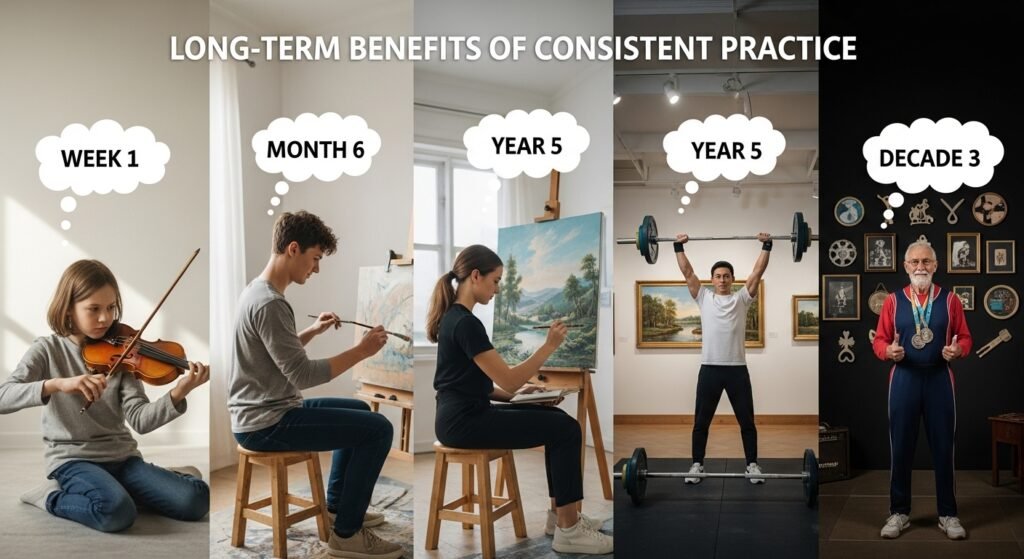
The real magic of meditation happens through consistency. Regular 15-minute daily sessions compound over time, creating profound changes in how you experience and respond to anxiety.
Enhanced Emotional Regulation: After several weeks of consistent practice, you’ll develop greater emotional resilience. Situations that previously triggered intense anxiety may still cause some stress, but your response will be more measured and manageable.
Improved Sleep Quality: Anxiety and insomnia often go hand in hand. Regular meditation practice helps quiet the mental chatter that keeps many people awake at night. Studies show that meditation practitioners fall asleep faster and experience deeper, more restorative sleep.
Increased Self-Awareness: Meditation develops your ability to recognize early warning signs of anxiety before they escalate into full-blown panic. This early detection allows you to implement coping strategies before reaching crisis mode.
Better Stress Management: While you can’t eliminate stress from your life, meditation changes your relationship with it. Regular practitioners report feeling more equipped to handle challenging situations with greater calm and clarity.
Enhanced Focus and Concentration: Anxiety often involves racing, scattered thoughts that make it difficult to concentrate on tasks. Meditation trains your attention like a muscle, improving your ability to focus on what matters most.
Reduced Reactivity: One of meditation’s most valuable benefits is learning to pause before reacting to stressful situations. This space between stimulus and response allows for more thoughtful, intentional choices rather than automatic anxiety-driven reactions.
Physical Health Benefits

The benefits of meditation extend far beyond mental health, creating positive changes throughout your entire body:
Cardiovascular Health: Regular meditation lowers blood pressure, reduces risk of heart disease, and improves circulation. The American Heart Association has recognized meditation as a potentially useful practice for reducing cardiovascular risk.
Immune System Support: Chronic anxiety suppresses immune function, making you more susceptible to illness. Meditation strengthens immune response by reducing inflammation and stress hormones that compromise your body’s defense systems.
Pain Management: Many chronic pain conditions are exacerbated by anxiety and stress. Meditation changes how your brain processes pain signals, often providing significant relief from conditions like headaches, fibromyalgia, and arthritis.
Digestive Health: The gut-brain connection means anxiety often manifests as digestive issues. Meditation improves gut health by reducing stress-related inflammation and promoting better digestion.
Creating the Perfect Environment for Meditation
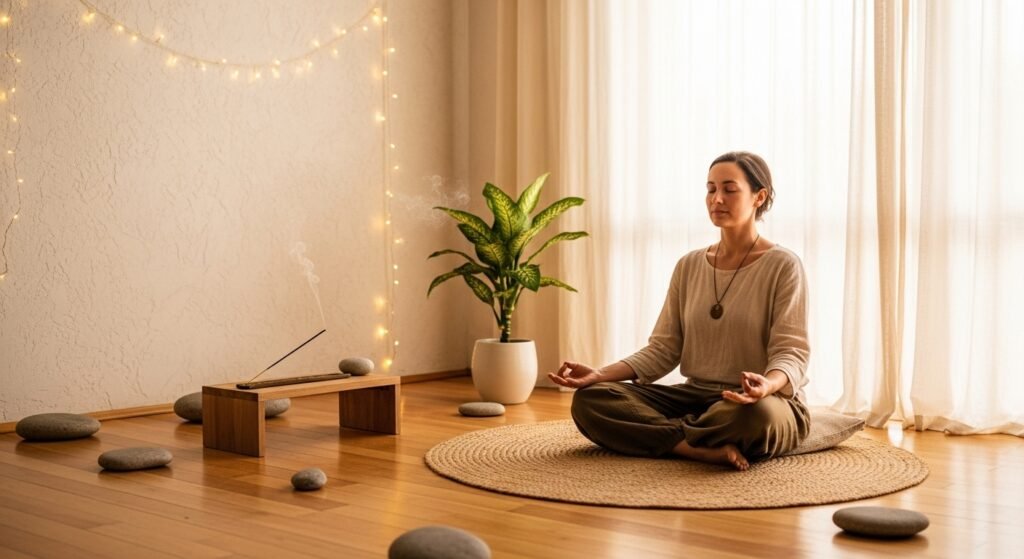
Choosing Your Meditation Space
Your meditation environment significantly impacts the quality of your practice. While you can meditate anywhere, creating a dedicated space helps signal to your mind that it’s time to shift into a calmer state.
Find a Quiet Corner: Select a location where you’re least likely to be interrupted. This might be a corner of your bedroom, a spot in your living room, or even a peaceful outdoor area. The key is consistency – using the same space regularly helps your mind associate that location with relaxation and inner peace.
Minimize Distractions: Turn off your phone or put it on silent mode. If you live with others, let them know you’ll be meditating and ask not to be disturbed unless there’s an emergency. Consider using a “Do Not Disturb” sign if helpful.
Comfort is Key: You don’t need to sit in an uncomfortable lotus position to meditate effectively. Choose a position that allows you to remain alert but relaxed. This might be sitting in a comfortable chair with your back supported, sitting cross-legged on a cushion, or even lying down if you won’t fall asleep.
Temperature Control: Ensure your space isn’t too hot or too cold. Being physically uncomfortable will make it harder to focus on your practice. A slightly cool room is often preferable to a warm one, as it helps maintain alertness.
Essential Items for Your Practice
While meditation requires no special equipment, a few simple items can enhance your experience:
Meditation Cushion or Chair: A dedicated meditation cushion (zafu) can help maintain proper posture and signal the beginning of your practice. If sitting on the floor isn’t comfortable, any chair that supports good posture works perfectly.
Timer or App: Use a gentle timer to track your 15-minute sessions without constantly checking the clock. Many meditation apps offer pleasant chimes or bells to mark the beginning and end of your practice.
Blanket: Having a light blanket nearby can be helpful if you tend to get cold during meditation or if you’re practicing body scan techniques that may make you feel cooler.
Journal: Keep a small notebook near your meditation space to jot down any insights, recurring thoughts, or progress observations after your session.
Optimizing Lighting and Sound
Natural Light: If possible, meditate near a window with natural light, but avoid direct sunlight that might be distracting. Soft, diffused natural light creates an calming atmosphere.
Artificial Lighting: If meditating indoors without natural light, use soft, warm lighting rather than harsh overhead fluorescents. Candles can create a peaceful ambiance, though they’re not necessary.
Sound Considerations: Complete silence isn’t required for effective meditation. Gentle background sounds like soft instrumental music, nature sounds, or white noise can actually help mask distracting environmental noises. However, avoid anything with lyrics or complex melodies that might capture your attention.
Managing Environmental Noise: If you live in a noisy environment, don’t let that prevent you from meditating. You can incorporate sounds into your practice by acknowledging them without judgment and returning your attention to your breath or chosen focus point.
Step-by-Step 15-Minute Meditation Guide

Preparation Phase (2 minutes)
Getting Settled: Find your comfortable position and take a moment to adjust your posture. Sit with your spine naturally straight but not rigid. If you’re in a chair, place both feet flat on the floor. If sitting cross-legged, use a cushion under your hips to reduce strain on your knees and back.
Hand Position: Rest your hands comfortably on your thighs or in your lap. You might place one hand on top of the other with thumbs lightly touching, or simply let them rest naturally. There’s no “correct” hand position – choose what feels most comfortable.
Eye Position: You can meditate with eyes closed or slightly open with a soft gaze downward. Closed eyes often help reduce visual distractions, while slightly open eyes can prevent drowsiness. Experiment to see what works best for you.
Setting Intention: Take a moment to set a gentle intention for your practice. This might be something simple like “I invite peace into my mind” or “I allow myself to rest in this moment.” Avoid making the intention too complex or goal-oriented.
Opening Awareness (2 minutes)
Body Check-In: Begin by noticing how your body feels in this moment. Are there areas of tension or discomfort? Don’t try to change anything – simply observe with gentle curiosity. Notice the feeling of your body making contact with your seat or cushion.
Environmental Awareness: Expand your awareness to include sounds around you – perhaps traffic outside, the hum of appliances, or birds singing. Rather than trying to block out these sounds, acknowledge them as part of your meditation environment.
Breath Awareness: Begin to notice your natural breathing rhythm without trying to control it. Feel the sensation of air moving in and out of your nostrils. Notice if your breathing is shallow or deep, fast or slow, without judgment.
Core Breathing Focus (8 minutes)
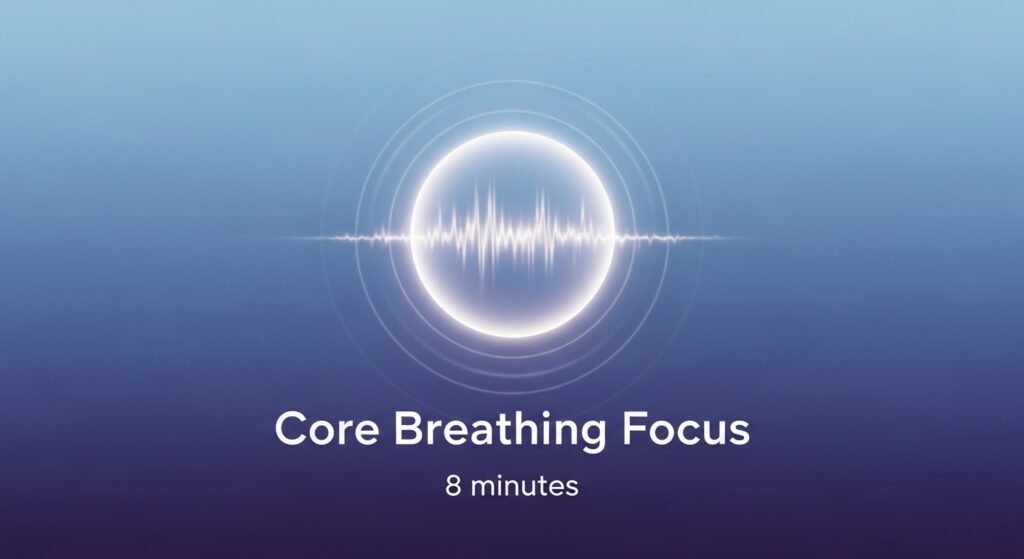
Finding Your Natural Rhythm: Allow your breath to settle into its natural pattern. You might notice that simply paying attention to your breathing naturally slows it down, but don’t force this to happen.
Breath Sensations: Focus on the physical sensations of breathing. You might notice the coolness of air entering your nostrils and the warmth as you exhale. Some people prefer to focus on the rise and fall of their chest or belly rather than nostril sensations.
When Your Mind Wanders: This is the most important part of the practice. Your mind will wander – this is completely normal and expected. When you notice your attention has drifted to thoughts, worries, or sounds, gently acknowledge where your mind went with a simple mental note like “thinking” or “worry,” then kindly redirect your attention back to your breath.
Working with Anxiety During Meditation: If anxious thoughts arise during your practice, don’t fight them or judge yourself. Instead, try these approaches:
- Acknowledge the anxiety with kindness: “I notice anxiety is here”
- Return your attention to your breath, using it as an anchor
- If anxiety feels overwhelming, open your eyes and focus on five things you can see in your immediate environment
- Remember that feeling anxious during meditation doesn’t mean you’re doing it wrong
Counting Technique: If you find it very difficult to maintain focus on breath alone, try counting each exhale from 1 to 10, then starting over. If you lose count or reach higher than 10, simply start again at 1 without self-criticism.
Dealing with Physical Discomfort: If you experience physical discomfort during these eight minutes, first try to simply observe the sensation without immediately moving. Often, minor discomforts will shift or disappear on their own. If the discomfort becomes genuinely distracting, mindfully adjust your position and return to your breath focus.
Expansion and Body Awareness (2 minutes)

Expanding Focus: Gradually expand your awareness beyond just your breath to include your entire body. Notice areas of warmth or coolness, tension or relaxation, without trying to change anything.
Full Body Breathing: Imagine that your entire body is breathing – that with each inhale, you’re drawing peace and calm into every cell, and with each exhale, you’re releasing tension and worry from your entire being.
Emotional Check-In: Notice what emotions might be present without judging them as good or bad. You might feel calm, restless, peaceful, or still somewhat anxious – all of these are perfectly acceptable experiences.
Closing Integration (1 minute)

Setting Intentions for Your Day: As you prepare to end your meditation, set a gentle intention for carrying this sense of peace with you. This might be remembering to take three conscious breaths before responding to stressful situations, or simply holding onto the memory of this peaceful moment.
Gradual Transition: Rather than abruptly ending your meditation, take your time transitioning back to regular activity. Wiggle your fingers and toes, gently move your shoulders, and slowly open your eyes if they were closed.
Appreciation: Take a moment to appreciate yourself for taking this time for inner peace and self-care. Regardless of how the meditation felt, you’ve given yourself a valuable gift.
Advanced Techniques for Deeper Practice
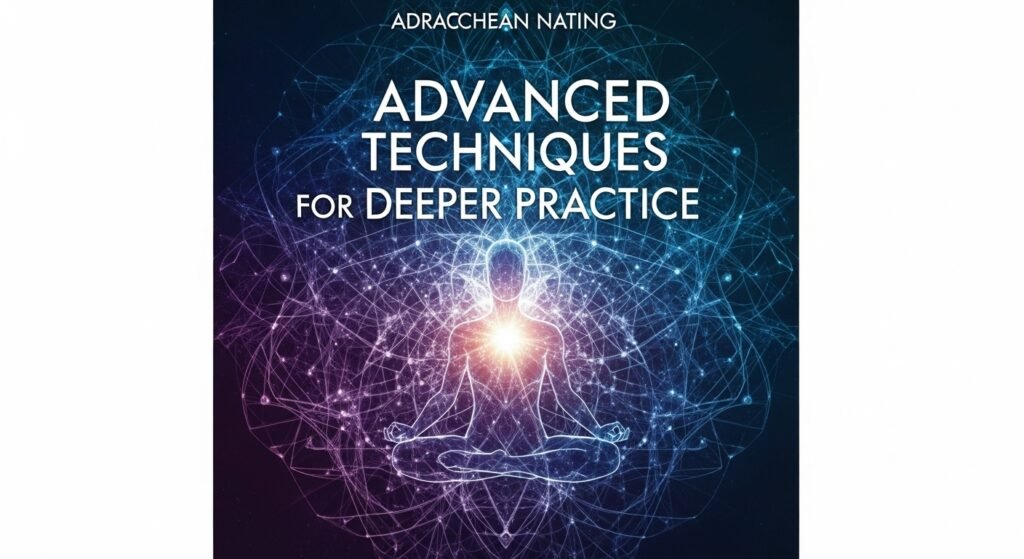
Working with Difficult Emotions
As your meditation practice deepens, you may encounter intense emotions including anger, sadness, or particularly strong anxiety. Rather than seeing these as problems to solve, view them as opportunities for growth and healing.
The RAIN Technique: This powerful method helps you work skillfully with difficult emotions:
- Recognize: What is happening right now? What emotions or sensations are present?
- Allow: Can you let this experience be here without fighting it or trying to fix it?
- Investigate: What does this feeling like in your body? Where do you feel it most strongly?
- Non-identification: Remember that you are not your emotions – you are the awareness experiencing them.
Breathing with Emotions: When strong emotions arise, try breathing “into” them rather than trying to breathe them away. Imagine your breath is gently surrounding the emotion with compassion and space.
Loving-Kindness for Anxiety
Anxiety often involves harsh self-criticism and worry about others’ opinions. Loving-kindness meditation cultivates a gentle, compassionate relationship with yourself and others.
Self-Compassion Practice: Begin by placing a hand on your heart and offering yourself kind wishes:
- “May I be free from anxiety and worry”
- “May I be kind to myself”
- “May I find peace in this moment”
- “May I trust in my ability to handle whatever comes”
Extending to Others: Gradually extend these wishes to loved ones, neutral people, difficult people, and finally all beings. This practice helps reduce the isolation that anxiety often creates.
Visualization Techniques
Safe Space Visualization: Create a detailed mental image of a place where you feel completely safe and peaceful. This might be a real location from your past or an imaginary sanctuary. During anxious moments, you can return to this visualization for comfort.
Anxiety as Weather: Visualize your anxiety as weather patterns passing through the sky of your awareness. Just as storms eventually pass, anxious feelings are temporary experiences moving through your consciousness.
Working with Physical Anxiety Symptoms
Progressive Muscle Relaxation: Systematically tense and release different muscle groups, starting with your toes and moving up to your head. This technique helps you recognize and release physical tension you might not have noticed.
Grounding Techniques: When anxiety creates feelings of disconnection or unreality, focus on physical sensations that connect you to the present moment:
- Feel your feet on the ground
- Notice the temperature of the air on your skin
- Hold an object and explore its texture, weight, and temperature
Common Challenges and Solutions
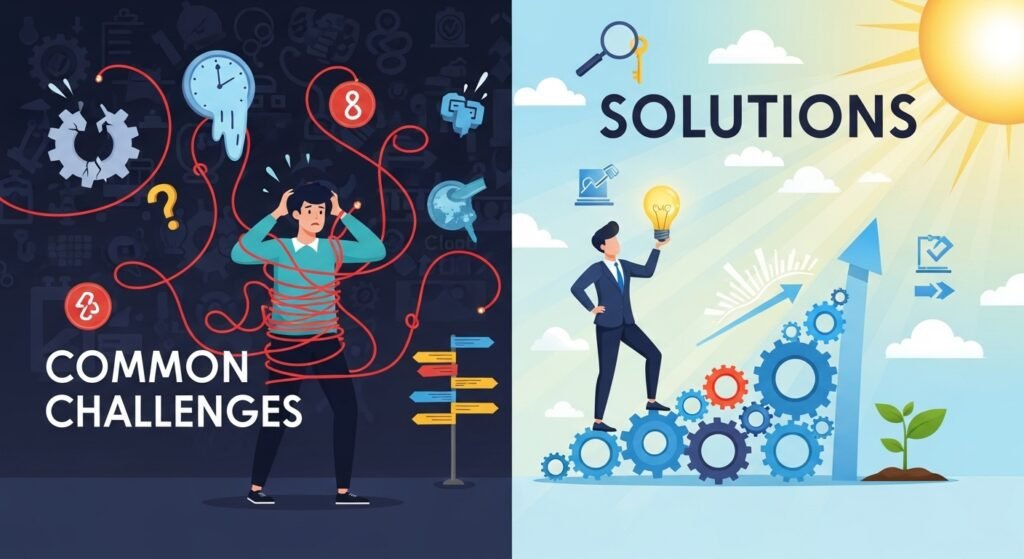
“My Mind Won’t Stop Racing”
This is the most common concern beginners express about meditation. The goal isn’t to stop your thoughts completely – that’s neither possible nor necessary for effective meditation.
Solution Strategies:
- Remember that noticing your mind wandering IS the practice, not a failure
- Try shorter sessions (5-10 minutes) initially if 15 minutes feels overwhelming
- Use guided meditations with more verbal instruction to help maintain focus
- Practice at times when you’re naturally calmer, such as early morning
Reframe Your Expectations: Instead of aiming for a completely quiet mind, aim for a different relationship with your thoughts. You’re learning to be the observer of thoughts rather than being caught up in their content.
“I Don’t Have Time”
Time constraints are a common barrier to establishing a meditation practice, especially when anxiety makes you feel like you need to be constantly productive.
Practical Solutions:
- Start with just 5 minutes daily and gradually increase duration
- Meditate first thing in the morning before other responsibilities take over
- Use waiting time (before appointments, during lunch breaks) for brief meditation
- Replace 15 minutes of social media or TV with meditation
Mindset Shift: Consider meditation not as another task to add to your busy schedule, but as an investment that makes you more efficient and less stressed throughout your day.
“I Fall Asleep During Meditation”
Falling asleep during meditation usually indicates that you need more rest, but it can also result from meditation position or timing.
Prevention Strategies:
- Meditate sitting up rather than lying down
- Practice at times when you’re naturally alert
- Ensure your meditation space isn’t too warm
- Get adequate sleep at night so you’re not overly tired during meditation
When Drowsiness Occurs: If you feel sleepy during meditation, you can:
- Open your eyes slightly
- Straighten your posture
- Take a few deeper breaths
- Accept that sometimes your body needs rest more than meditation
“I Don’t Feel Any Different”
Some people expect immediate, dramatic changes from meditation and become discouraged when they don’t feel instantly transformed.
Understanding Subtle Changes:
- Benefits often accumulate gradually and may be more noticeable to others than to you
- Keep a brief journal noting your mood, sleep quality, and stress levels
- Notice small changes like feeling slightly less reactive to minor annoyances
- Remember that preventing anxiety from getting worse is a significant benefit
Patience with the Process: Meditation is like physical exercise – you wouldn’t expect to run a marathon after one workout. Similarly, meditation benefits develop through consistent practice over time.
“My Anxiety Gets Worse During Meditation”
Sometimes sitting quietly allows suppressed worries to surface, making anxiety temporarily feel more intense.
Working with Increased Anxiety:
- Remember that this is often a sign that meditation is helping you process stored stress
- Keep your eyes open if closing them feels too intense
- Try walking meditation or gentle movement if sitting still increases anxiety
- Use guided meditations that provide more external focus
When to Seek Additional Support: If meditation consistently increases your anxiety rather than providing relief, consider working with a qualified meditation teacher or mental health professional who can help you develop a practice suited to your specific needs.
Building a Sustainable Daily Practice
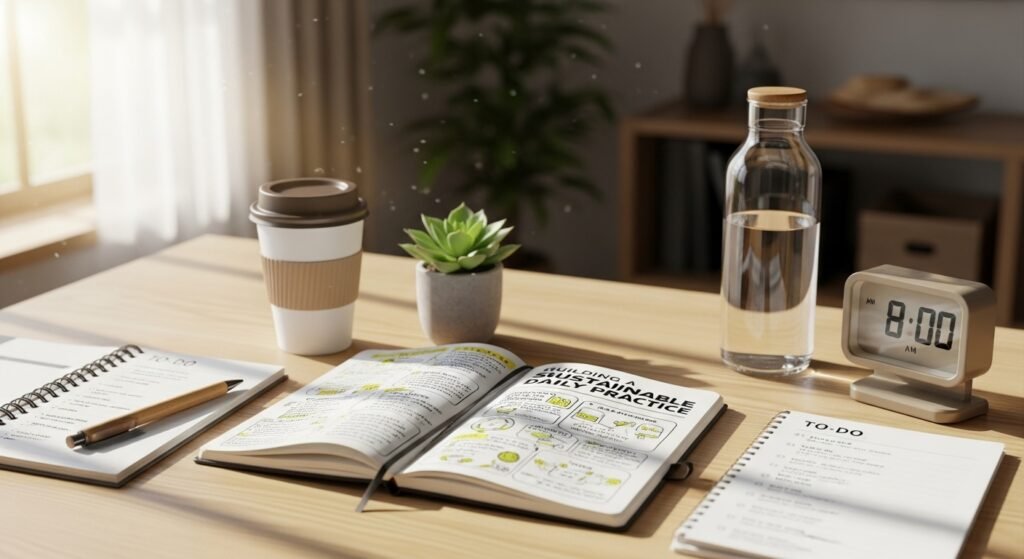
Starting Small and Building Consistency
The most successful meditation practices begin modestly and grow organically. Rather than committing to an hour daily and burning out after a week, start with what feels genuinely manageable.
Week 1-2: Establishment Phase
- Practice 5-10 minutes daily
- Focus on showing up consistently rather than perfect technique
- Use guided meditations for additional support
- Notice what time of day works best for your schedule
Week 3-4: Expansion Phase
- Gradually increase to 15 minutes daily
- Experiment with different meditation styles to find your preferences
- Begin incorporating meditation principles into daily activities
Month 2 and Beyond: Integration Phase
- Maintain consistent 15-minute daily practice
- Add brief meditation breaks during stressful moments
- Explore joining meditation groups or classes for additional support
Creating Accountability and Motivation
Meditation Tracking: Use a simple calendar or app to mark days you meditate. Seeing your consistency streak can provide motivation to continue.
Finding Community: Join local meditation groups, online communities, or partner with a friend who’s also interested in developing a practice. Sharing experiences and challenges makes the journey less solitary.
Regular Check-ins: Weekly, reflect on how meditation is impacting your anxiety levels, sleep quality, relationships, and overall well-being. Noticing positive changes reinforces your commitment to practice.
Adapting Practice for Different Life Circumstances
Travel: Develop a portable practice that doesn’t require special equipment or location. Simple breathing exercises or body scans can be done anywhere.
Illness: On days when you’re not feeling well, gentle meditation can support healing. Consider lying down meditations or practices focused on sending kindness to your body.
High Stress Periods: During particularly challenging times, you might need to shorten your practice but try to maintain consistency. Even three minutes of conscious breathing is beneficial.
Busy Schedules: Find creative ways to incorporate mindfulness throughout your day – mindful walking between appointments, conscious breathing while waiting, or brief body scans during work breaks.
Integrating Meditation with Other Anxiety Management Strategies
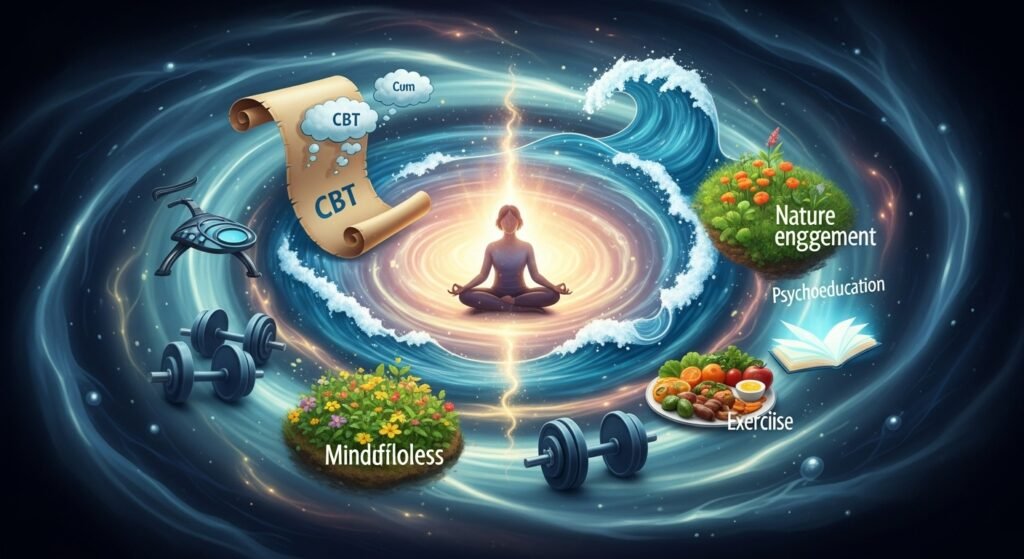
Combining with Professional Treatment
Meditation is a powerful complement to professional mental health treatment, not a replacement for it. If you’re working with a therapist or psychiatrist, discuss how meditation might support your treatment plan.
Cognitive Behavioral Therapy (CBT): Meditation enhances CBT by helping you observe thought patterns without immediately believing or reacting to them. The mindful awareness developed through meditation supports the cognitive restructuring work done in therapy.
Medication Management: While meditation can reduce anxiety symptoms, never stop prescribed medications without consulting your healthcare provider. Many people find that meditation enhances the effectiveness of their medication while potentially allowing for lower doses over time.
Crisis Support: Meditation teaches valuable skills for managing anxiety, but it’s important to have additional resources for crisis situations. Maintain connections with mental health professionals, crisis hotlines, and trusted friends or family members.
Lifestyle Factors That Enhance Meditation Benefits
Sleep Hygiene: Quality sleep and meditation create a positive cycle – meditation improves sleep, and adequate rest makes meditation easier and more effective.
- Maintain consistent sleep and wake times
- Create a calming bedtime routine that might include brief meditation
- Avoid screens for at least an hour before bed
- Keep your bedroom cool, dark, and quiet
Physical Exercise: Regular movement complements meditation by reducing physical tension and improving mood through endorphin release.
- Walking meditation combines movement with mindfulness
- Yoga naturally integrates physical postures with breath awareness
- Any exercise you enjoy can support your overall well-being and make meditation easier
Nutrition: What you eat affects your mental state and ability to meditate effectively.
- Limit caffeine, especially before meditation, as it can increase anxiety and restlessness
- Avoid meditating immediately after large meals when you might feel sluggish
- Stay hydrated throughout the day
- Consider how different foods affect your anxiety levels and adjust accordingly
Building Mindfulness Throughout Your Day
Mindful Transitions: Use brief moments of mindfulness between activities to maintain the peaceful awareness cultivated during formal meditation.
- Take three conscious breaths before checking email or answering the phone
- Notice physical sensations while walking from one location to another
- Pause to appreciate something beautiful you encounter during your day
Mindful Communication: Apply meditation principles to interactions with others.
- Listen fully without preparing your response
- Notice when anxiety arises during conversations and return to breath awareness
- Practice pausing before reacting to challenging communications
Workplace Mindfulness: Integrate brief mindfulness practices into your work routine.
- Set hourly reminders for three conscious breaths
- Practice mindful eating during lunch breaks
- Use waiting time (elevators, traffic) for mini-meditations
Measuring Your Progress and Celebrating Success

Tracking Anxiety Relief
Keep a simple log of your anxiety levels before and after meditation sessions using a scale of 1-10. Over time, you’ll likely notice patterns such as:
- Lower baseline anxiety levels
- Quicker recovery from stressful situations
- Improved ability to recognize early anxiety signs
- Better sleep quality and mood stability
Recognizing Subtle Improvements
Meditation benefits often appear gradually and may be more apparent to others than to yourself:
- Friends or family members might comment on your increased calmness
- You may find yourself less reactive to minor irritations
- Decision-making might feel clearer and less overwhelming
- Physical tension and headaches may decrease in frequency
Celebrating Non-Scale Victories
Consistency Achievements: Celebrate meditation streaks – completing 7 days, 30 days, or 100 days of practice represents significant commitment to your well-being.
Skill Development: Notice when you successfully apply meditation techniques outside your formal practice sessions – using breath awareness during a stressful meeting or practicing self-compassion during difficult moments.
Relationship Improvements: Many people find their relationships improve as meditation increases patience, compassion, and emotional regulation.
Conclusion: Your Journey to Inner Peace
Embarking on a daily 15-minute meditation practice for anxiety relief represents a profound commitment to your mental health and overall well-being. Throughout this comprehensive guide, you’ve learned that meditation isn’t just a temporary relaxation technique – it’s a scientifically-backed practice that literally rewires your brain for greater resilience, emotional regulation, and peace of mind.
The journey you’re beginning is uniquely yours. Some days your meditation will feel effortless and deeply peaceful. Other days, your mind may feel particularly busy or your anxiety more prominent. Both experiences are valuable parts of your growth. Remember that meditation isn’t about achieving a perfect state of calm – it’s about developing a different relationship with whatever arises in your consciousness.
The 15-minute daily practice outlined in this guide provides a solid foundation, but feel free to adapt it to your specific needs and circumstances. You might find that certain techniques resonate more strongly with you, or that different approaches work better during different seasons of your life. This flexibility and self-compassion are essential elements of a sustainable practice.
As you continue your meditation journey, remember that seeking support is a sign of wisdom, not weakness. Whether through meditation groups, apps, books, or professional guidance, connecting with resources and community can enrich your practice and provide encouragement during challenging times.
The investment you’re making in these 15 minutes each day will pay dividends in every area of your life. Your relationships will benefit from your increased patience and presence. Your work will benefit from your improved focus and stress management. Most importantly, you’ll benefit from a deeper sense of inner peace and the confidence that comes from knowing you have powerful tools for managing whatever life brings your way.
Your anxiety doesn’t define you, and it doesn’t have to control your life. With consistent practice, patience, and self-compassion, meditation can become your pathway to a calmer, more peaceful existence. The journey of a thousand miles begins with a single step – and your first step is as simple as taking a conscious breath.
Start today. Start now. Your future self will thank you for this gift of inner peace and emotional freedom. The transformation begins with your very next breath.
